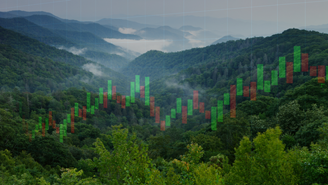Last month’s COP27 U.N. Climate Change Conference emphasized the connection between climate change and biodiversity preservation. Finance Day within the U.N. Biodiversity Conference (COP15) is fast approaching, and Morningstar Sustainalytics’ team members will be in attendance, each focusing on different investor biodiversity considerations related to active ownership and data solutions.
COP15 seeks to establish a global deal to halt and reverse nature loss towards the objective of living in harmony with nature by 2050. Biodiversity loss is now widely recognised as a financially material risk whereby more than half of global GDP is moderately or highly dependent on biodiversity and ecosystem services.i Historically, the financial sector has had a limited role in the participation of the CBD (Convention of Biological Diversity) process; however, the level of engagement between financial institutions and Parties is higher than ever. This year, COP15 established a dedicated Finance for Biodiversity Day (December 14, 2022), focusing on the role of financial institutions in delivering the ambitions of the Global Biodiversity Framework.
Sune Andersen, a Senior Analyst and Lead of Sustainalytics’ thematic engagement programme, Biodiversity and Natural Capital, has been invited to support the Danish Environmental Ministry in an advisory capacity. With access to the policy negotiations, he will follow developments on the draft of the Global Biodiversity Framework, surveying potential outcomes that will shape the evolution of investor support to align with international biodiversity guidelines. In this article, Sune and Sustainalytics’ biodiversity thematic expert Gayaneh Shahbazian share their perspectives on the importance of establishing a new global agreement to address biodiversity loss for investors and financial institutions.
Collecting insight for a new biodiversity frontier in responsible investing
As part of the Danish delegation for COP15, Sustainalytics joins other stakeholders in providing input to the negotiation process of the Global Biodiversity Framework. Our team will gather critical insights and have the opportunity to connect directly with investors, NGOs, financial institutions, and government officials, creating meaningful opportunities to share our perspective and roadmap on how the future of biodiversity could look on a global scale.
Additionally, several cross-functional team members from Sustainalytics are attending the conference to discover how to enhance support for investors. We will observe best practices in corporate biodiversity programs and learn more about opportunities for incorporating biodiversity in current and future solutions.
Measuring biodiversity and deforestation Material ESG Issues offer portfolio evaluation criteria for investors
Within Sustainalytics’ ESG Risk Ratings methodology, investors leverage ESG data indicators for biodiversity and deforestation management. These programs signal how effectively a company is managing (a part of) its exposure to relevant Material ESG Issues. Companies operating in locations of high biodiversity exposure or managing products and services associated with deforestation are assessed on the strength of their disclosed biodiversity and/or deforestation programs. Current key assessments within Sustainalytics’ public equities research universe show that many companies do not sufficiently address biodiversity-related risk. For example, 41% of the Utility industry and 47% of Oil & Gas producers either have a weak or no biodiversity program in place.
The agricultural value chain (including restaurants, agriculture, packaged foods, tobacco, and food retail sub-industries), a key sector for investor consideration, denotes inadequate management of its deforestation-related risk, whereby 62% either have a weak or no deforestation program.
Current active ownership leaders in biodiversity
Morningstar’s report, COP15: A Turning Point for Investor Approaches to Biodiversity, examines the policies and publications of 25 U.S. and European asset managers. The findings show that 13 of the 25 asset managers provided detail on their active ownership approach to biodiversity. Out of the top five global asset managers, only BlackRock and Capital Group made significant specific comments about their approach to investment stewardship on biodiversity.
Involvement with the Global Biodiversity Framework negotiations will offer a better understanding of new regulations affecting issuers and investors regarding research, data, and disclosure. In turn, Sustainalytics aims to incorporate globally defined nature-related risks to support meaningful investor decision-making. Investors can leverage the power of stewardship by joining nature-related engagement programs like Morningstar Sustainalytics’ Biodiversity & Natural Capital Impact and Climate Change – Sustainable Forests and Finance.
Mind the biodiversity-climate change connection
The evaluation of biodiversity risk is key to addressing climate change. Nature-based solutions are estimated to provide 37% of climate mitigation until 2030.ii Following COP27 this past November, and with all eyes on the 15th U.N. Conference on Biodiversity in Montreal, now is a pivotal opportunity to draw attention to the climate-biodiversity nexus and bring biodiversity into the same responsible investing arena as climate change. We look forward to connecting with different biodiversity and ESG actors to create meaningful relationships for future opportunities in the investment industry.
Sources:





